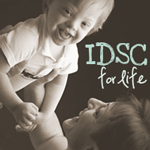A new study has recently been done in Down Syndrome mice that was to try to find which extra genes are responsible for the brain defects in people with DS (and in particular DS Mice in this study).
There are so many genes responsible for all the delays, impairments, etc that are present in Down syndrome. The puzzle is so large and complex scientists do not know the full spectrum of which genes, what gene overdoses, overexpressions, protein overexpressions, gene or protein deficiences are responsible for the syndrome. There have been quite a few studies done showing where the problems stem from in DS, but it hasn't unraveled the whole syndrome, which should be obvious.
While there is nothing known to counter the bad caused by Olig1 & Olig2 (the two genes studied in this new study) at this time, it is promising that the researches concluded the study that these genes may be "biomarkers for the rational development of early interventional therapies of the cognitive impairments in DS."
In the new study led by Tarik Haydar, then at the Children's National Medical Center in Washington, D.C., the scientists sought to determine which of the extra genes in the DS mice are responsible for brain defects. (Haydar is currently a professor of anatomy and neurobiology at Boston University School of Medicine.) Their results were published online July 18 in Nature Neuroscience (Scientific American is a part of Nature Publishing Group).
First, the scientists found abnormal proportions of excitatory and inhibitory neurons in the brains of the embryonic DS mice, with a much higher quantity of the inhibitory cells. Then they looked over the list of extra genes present in the DS mice and homed in on Olig1 and Olig2, which are known from previous studies to program the developing brain to produce inhibitory neurons. They then engineered a generation of DS mice to have the normal genetic dosage of these genes. They found that simply eliminating the superfluous copies of Olig1 and Olig2 prevented the brain defects and restored normal communication among the neurons.
"This is an extremely elegant set of experiments, which are very difficult to do," says Roger Reeves, professor of physiology at Johns Hopkins University School of Medicine who studies mechanisms of gene action in Down's syndrome and was not involved in the study. The results "very much expand our understanding of just how these imbalances come to be in the first place, and demonstrates the specific role of [these genes] in this imbalance," Reeves says. He adds that the findings have important implications for several different drugs designed to ameliorate cognitive deficits in DS that are currently making their way to clinical trials.
The next step will be to determine whether the adult mice behave differently or perform better on learning and memory tests. Reeves points out that scientists have questioned the validity of such tests in recent years, but says that altogether the team's data "strongly imply" that the modified mice would perform better in functional tests.
Although it is too soon to say how these findings may relate to humans with DS, Haydar points out that humans also have Olig1 and Olig2, and the proteins derived from these genes perform similar functions in mice and humans. The researchers conclude in their paper that these genes may be useful as "biomarkers for the rational development of early interventional therapies of the cognitive impairments in DS."
Haydar also hopes that his team can use the results to begin searching for molecules that influence the expression of Olig1 and Olig2 in order to prevent the brain defects in DS mice. Such experiments could lead to new human treatments for cognitive impairment in DS, which is often the most debilitating aspect of the disorder.
"It's been a very tough nut to crack," Haydar says. Progress toward understanding the genetic basis for the defects in DS has been discouraging partly because of the large number of genes potentially involved, and also because so many things are changed, he explains. "That these two genes just by themselves do major things was a big surprise," he adds. "It gives us hope to unravel this mystery."
























1 comments:
Interesting to see a therapy targeted to a gene, two genes in fact.
Trisomy 21 mice...
Will be interesting to read about Olig1 and Olig2.
Post a Comment